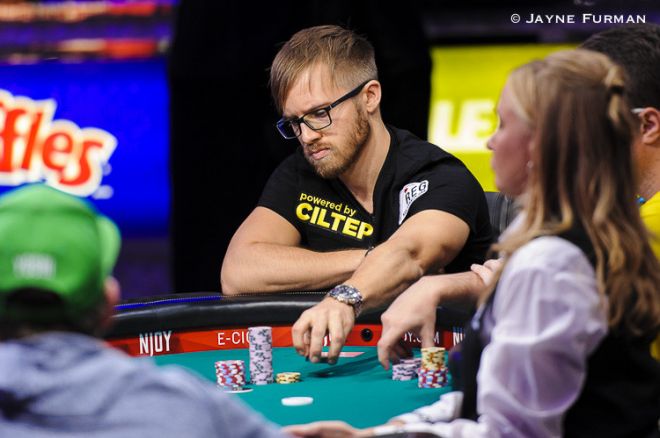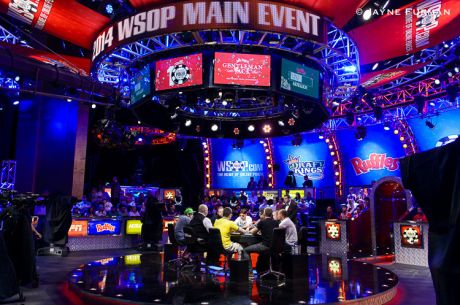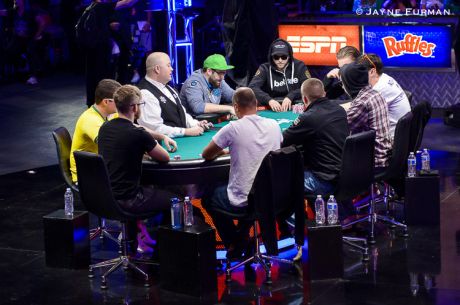Pushing His Way to a WSOP Main Event Title: A Look at Martin Jacobson��s All-Ins

The newest World Series of Poker Main Event champion Martin Jacobson was famously all-in an impressive 19 times during the first day of the final table of the November Nine last week. Thanks to the collation of hole cards from the ESPN almost-live broadcast by the bleary-eyed Martin Harris, we have an idea of just how many bullets Jacobson was dodging.
Hand #58
Just two hands after Mark Newhouse busted in ninth for a second consecutive year, a short-stacked Jacobson shoved his small blind preflop over an opening min-raise from Dan Sindelar, a reraise worth about 40% of Sindelar��s stack. Sindelar had raised with 9?7? and Jacobson��s shove was with A?J?, meaning Jacobson was would��ve been ahead 60% to 40% had Sindelar called.
Hand #66
On the next orbit, Sindelar tried the button min-raise again, starting with roughly the same chip advantage (49 BB to 20 BB). This time Sindelar had K?3?, with Jacobson holding 9?9? in the small blind �� a 2-to-1 advantage for Jacobson. Again Sindelar folded to Jacobson��s push.
Hand #76
Chip leader William Tonking opened for 1.1 million of his 54.5 million stack with 6?6? and Jacobson went all-in for just over 10 million with A?K?, making it the first time he was nominally behind when pushing all-in: 55% for Tonking vs. 45% for Jacobson. Tonking let it go.
Hand #81
Sindelar was down to a little more than 20 million with the end of the 250,000/500,000 level approaching, and he opened to 1.25 million from the small blind with Q?4? only to have Jacobson �� whose stack was nearing 60% of the size of Sindelar��s �� shove with 8?8? and better than 70% equity. Sindelar folded a third time to a Jacobson push.
Hand #84
Jacobson waited all of three more hands to shove yet again, this time after an opening raise from Tonking (still in the chip lead with 54.5 million). Jacobson was all in for 13.175 million from the cutoff holding A?J? with two slightly shorter stacks behind �� those of Bruno Politano and Billy Pappas �� and Felix Stephensen with 21 million in the big blind also left to act. All folded, then Tonking folded his J?10? and avoided the 73%-27% confrontation.
Hand #91
With Jacobson on the button, yet another raise from Sindelar on his right got picked off. This time Sindelar opened to 1.3 million with A?6? after having his stack chipped down to 18.5 million, then folded after Jacobson shoved for nearly 15 million with 9?9?. Again, Jacobson had more than 70% equity preflop.
Hand #112
While this hand didn��t actually put Jacobson at risk, it certainly could have crippled him and kept him from going deeper. With Politano and Sindelar having been eliminated in quick succession during the previous 20 hands, Jacobson was once again near the bottom of the counts with six players left. The only player with fewer chips was Pappas, now on Jacobson��s immediate left.
Action folded to Jacobson in the small blind who shoved with Q?3? to put Pappas all-in for his last 6.5 million. With about four orbits before he would blind out and holding K?J?, Pappas called Jacobson and won the 64%-36% matchup, dropping Jacobson down to just 15 big blinds.
Hand #117
Soon after Pappas would double again with pocket kings. Meanwhile, Jacobson was the short stack once more, having dipped below 9 million chips with Andoni Larrabe in next-to-last with 12.8 million. Jorryt van Hoof was back in the lead with more than 70 million chips, and he opened from the cutoff for 1.4 million with K?2?. Jacobson then shoved his big blind with A?8? �� a 61% to 39% advantage �� and van Hoof folded.
Hand #118
Tonking took the next shot at Jacobson with 8?7? from the button (and 62 million). Jacobson snap-shoved from the small blind for about 11 million holding A?2?. Pappas had 25 million in the big blind, and he folded. Tonking folded as well, turning down a spot in which Jacobson would have been ahead 57% to 43%.
Hand #138
Jacobson had gotten involved with Stephensen in Hand #125, losing 2.6 million chips when he was outdrawn on the river. Blinds and antes over three orbits then whittled his small stack to a meager 6.5 million chips, with blinds at 400,000/800,000 and a 100,000 ante. Larrabe was also short with just 9.5 million, while the other four players ranged from 27.3 to 72.6 million.
On this hand, action folded to Jacobson in the cutoff, and he open-shoved 8 BB with A?7?. In the big blind, van Hoof had nearly 90 BB behind, but elected to fold his 10?2? and avoid a showdown in which Jacobson would have been a 2-to-1 favorite.
Hand #145
This had proved the true turning point for Jacobson. Larrabe had eliminated in sixth place by van Hoof in Hand #140. Pappas was in fourth, sitting with four times Jacobson��s last-place stack. Jacobson shoved from under the gun for 6.3 million with A?8? and was called by Tonking in the big blind with K?J?. Jacobson won the 57%-43% battle and doubled back out of the danger zone.
Hand #156
The double-up gave Jacobson room during the next two orbits to do something other than shove, but on this hand in the big blind he went all in for 17 million chips after a raise from Stephensen for 1.7 million from the cutoff. Stephensen �� who would have had less than 6 million left if he��d lost �� thought it over for a full minute before releasing his 5?5?, a hand against which Jacobson��s 6?6? would have been better than a 81% to 19% favorite.
Hand #191
Through seven five-handed orbits, Jacobson didn��t need to go all in. By Hand #176 he��d climbed to second place on the leaderboard, though was still far, far behind van Hoof��s 100 million. Jacobson then doubled up the short-stacked Stephensen for 11.7 million on Hand #184.
With a little more than 16 million, Jacobson reraise-shoved from the big blind with 10?10? over a button raise of 1.8 million from van Hoof who held Q?5?. Van Hoof let it go, forgoing a 68% to 32% matchup in which he��d have been the underdog.
Hand #193
The blinds increased to 500,000/1,000,000 with a 150,000 ante, and Van Hoof min-raised from under the gun with A?4?. Jacobson then shoved from the button with K?Q? �� a hand against which van Hoof would have had a 55%-45% edge �� and the latter stepped aside.
Hand #197
Jacobson had A?4? in the small blind and after the action folded to him shoved for 18 million. Pappas in the big blind had more than 29 million behind, and he elected to fold 8?2? and not risk two-thirds of his stack in a spot where��d he would have had a little over 35% equity.
Hand #203
Just over an orbit later there had been some movement on the leaderboard. Stephensen had doubled through van Hoof, moving him from last place to second, then Jacobson had taken both his hands in the blinds (#201 and Hand #202) uncontested. The three smallest stacks (Jacobson, Pappas, and Tonking) were all within just a few big blinds of each other, in the low-to-mid 20 millions.
On this hand, van Hoof min-raised under the gun with A?10?, Jacobson went all in for 22.4 million from the button holding A?A?, and van Hoof folded with 82.6 million behind, avoiding the 91% to 9% matchup.
Hand #208
A small blind shove into Pappas��s big blind earlier in the tournament had nearly cost Jacobson the championship. This time, with Pappas barely covering him, Jacobson went all in with 5?5? and was slightly ahead of the A?J? in Pappas��s hand �� 54% to 46%. It��s possible Pappas took into consideration Jacobson��s earlier shove with Q?3?, or he might have just thought he was likely in better shape than Jacobson. In any event Pappas called, Jacobson hit a set on the flop, and Pappas was out on the next hand after having made an impressively deep run against tough competition. Meanwhile with four left, Jacobson had moved into a solid second place.
Hand #223
The previous hand to this one had been a disaster for Jacobson, with Stephensen making runner-runner trip queens in an A?K?-versus-K?Q? battle, causing Jacobson to slip to 14.9 million chips.
Van Hoof then made it 2.2 million from the button with A?5?, and Jacobson called from the big blind holding J?8?. The flop was Q?10?9?, giving Jacobson a flopped straight plus a straight flush draw. The players checked to the 4? turn and Jacobson bet 3.5 million on his flush. Van Hoof called the turn bet, having nearly quadrupled his 3% postflop equity after the turn brought him an ace-high flush draw. Following the 2? river, Jacobson put his last 9 million in the pot, and van Hoof folded. This hand moved Jacobson out of the basement and slightly ahead of Tonking, and set up Tonking��s elimination on the next hand.
Hand #224
Van Hoof opened under the gun to 2.2 million, and Tonking shoved 20 million from the button. Jacobson then reshoved from the small blind for just 1.4 million more than Tonking��s bet. Van Hoof folded his Q?7?, and Tonking took 2?2? up against Jacobson��s 10?10?, with Tonking having just 18% equity for preflop. The board ran out 4?5?J?6?Q?, with Tonking��s chances improving to over 40% after the flop and still above 30% on the turn thanks to straight and flush outs.
As the final table��s first day neared an end, this would mark the last point at which Jacobson put his tournament life on the line on his way to the championship. During the remainder of Day 1, Jacobson picked up a few million chips (mostly from van Hoof). Then 20 hands into the final day of play he��d take the chip lead and never let it go again.
Surviving 19 Shoves
On Day 1 of the November Nine, Jacobson went from the second-shortest stack of nine to second in chips with three left, navigating his way through a long period sitting at or near the bottom of the counts and enduring a couple of dramatic setbacks that might have demoralized many a player. He was at risk for a high percentage of his hands �� while the entire final table took 328 hands, the period detailed above (Hand #58 through #224) was less than half that, during which stretch Jacobson was all in at least once in every nine hands.
Of the 19 hands described above, Jacobson entered the hand with better than 50% equity in all but three instances, including the last where he had 56% equity preflop three-way even before van Hoof��s fold. Only four of the hands went to showdown, with his only loss versus Pappas, when Jacobson was behind and �� most importantly �� not actually at risk.
Twelve of Jacobson��s all-ins were made from the blinds. Twelve of them were three-bets over opening raises and five were opening raises, with the anomalies coming in the last two instances where he didn��t go all in until the river (#223) and he four-bet shoved (#224). Nine of his all-in hands included an ace (with one of those including two), and seven were with pocket pairs, though the A?A? hand was the only pair he had higher than tens.
Hindsight is $10,000,000
The last hand where Jacobson was at risk is interesting from a tournament strategy perspective. If van Hoof �� with more than 101.6 million chips to start the hand �� had chosen to call, there were three likely outcomes (setting aside the rare split pots):
- Tonking wins. With Tonking and Jacobson all in and a call from van Hoof, there would have been a main pot of 62.1 million, and a side pot of 1.7 million (Jacobson had Tonking covered by less than a million after paying his small blind). A win by Tonking would have pushed him into second place after winning the main pot. Jacobson would have been eliminated or left with just the side pot, not even enough to get him through the next orbit. Van Hoof would have retained first place with over 80 million.
- Jacobson wins. If Jacobson would have won a three-way battle, he��d have just under 64 million, van Hoof would still have 80 million, and Tonking would be out.
- Van Hoof wins. This would have been the result if van Hoof had called Jacobson��s 4-bet, since the queen on the river would have paired his hand. He would have been heads-up holding more than 140 million chips against Stephensen with less than 60 million.
In a cash game, van Hoof��s decision to get out of the way of the four-bet secondary shove by Jacobson is absolutely the right move, but in the last stage of a tournament with his stack size and huge pay jumps on the line, it might have been conservative. Jacobson made his decision to shove over Tonking in about six seconds, then van Hoof folded in less than that. But you have to wonder if he��d taken some more time to crunch the numbers whether he��d have made the call that would have prevented Jacobson from making it past third and locked up at least second place for himself (with a very good chance at the championship).
But van Hoof didn��t, and Jacobson won the hand. Then a night later Jacobson would win the very last all-in of the tournament, too, versus Stephensen �� holding the exact same 10?10?.
Darrel Plant lives in Portland, Oregon. A computer programmer by profession and a game player at heart, he writes about math and poker at his blog, Mutant Poker.
Get all the latest PokerNews updates on your social media outlets. Follow us on Twitter and find us on both Facebook and Google+!








